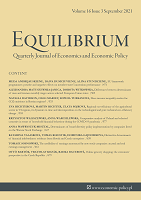The role of the One-Belt One-Road initiative in China’s exports and global value chains
The role of the One-Belt One-Road initiative in China’s exports and global value chains
Author(s): Joanna Wolszczak-Derlacz, Yuxin LuSubject(s): International relations/trade, Methodology and research technology
Published by: Instytut Badań Gospodarczych
Keywords: One-Belt One-Road; China; gravity trade models; global value chains;
Summary/Abstract: Research background: China is regarded as the “world factor” highly involved in international trade and plays an increasingly important role in the global value chains (GVC). Additionally, the “One-Belt One-Road” (OBOR) initiative was proposed by the Chinese government to further promote China in the international market. Purpose of the article: The article explores the role of the OBOR in China’s exports and global value chain. It aims at: 1) verifying how OBOR impacts the volume of China's export and value added export to its partners. 2) checking whether or not OBOR strengthens the industrial connection between China and its participants at the GVC level. 3) examining the different roles of corridors in China's exports and GVC. Methods: The empirical analysis is based on the augmented gravity model of international trade, which comprises China and its 197 partners in the period 2000–2018. The model is estimated for gross export as well GVC measured by domestic value added in export and the value contributed by a partner to China’s exports. Findings & value added: In general, there is a significant positive correlation between OBOR and the volumes of China’s export, domestic value-added trade and the value of partner’s contributed in China’s export. However, some of the results are blurred by OLS and FE methods. The author points out that FE-PPML estimation methods are more adequate. Among the six economic corridors, Bangladesh-China-India-Myanmar (BCIM), China-Pakistan (CP) and China Indochina Peninsula (CIP) were proven to play a prominent role in promoting China’s export, DVA and strengthening the links of global value chains. It is worth noting that the China-Mongolia-Russian Federation (CMRF) corridor harms China's export and DVA trade, and at the same time promotes countries in its region that benefit from trade with China.
Journal: Equilibrium. Quarterly Journal of Economics and Economic Policy
- Issue Year: 17/2022
- Issue No: 2
- Page Range: 317-341
- Page Count: 25
- Language: English

